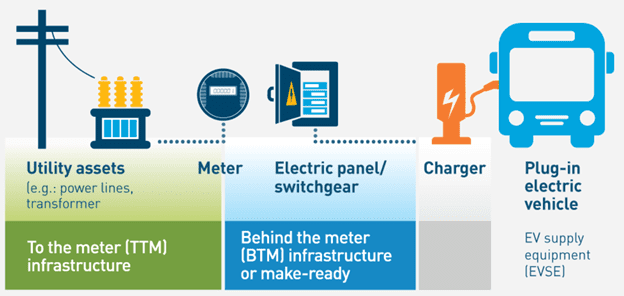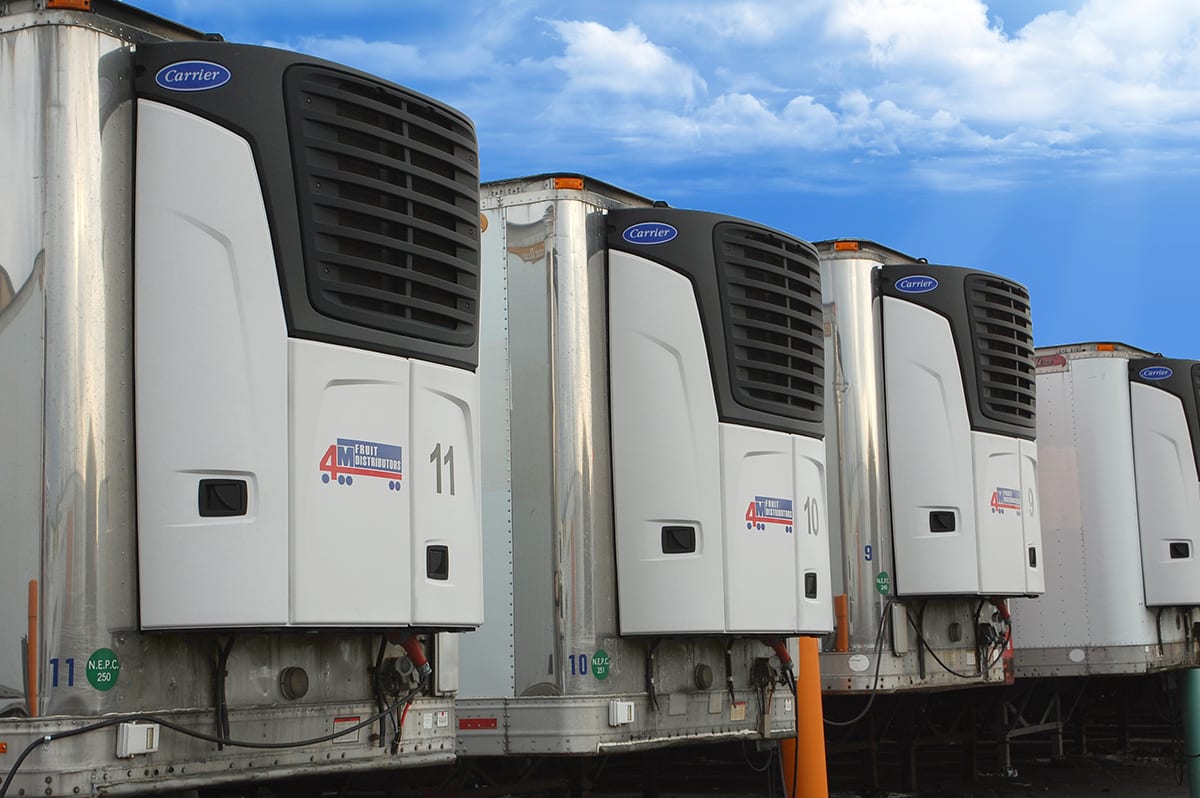In partnership with: Pacific Gas & Electric Company (PG&E)
Modern grocery shopping is made possible by transport refrigeration units (TRUs), which are devices mounted on trailers, containers, or trucks that refrigerate perishable cargo. While the tens of thousands of TRUs operating in California give us access to fresh food and other temperature-sensitive goods, they are also a major source of air and climate pollution.
More than 19% of the toxic air contaminants from the state’s goods movement industry come from TRUs. TRUs are powered by the vehicle’s diesel engine while on the road, and when the truck is parked, they are either powered by the truck or a separate standby engine, which is also usually fueled by diesel. Most emissions from operating TRUs come from the diesel engines that continue to run while the trucks are stationary, for example, while waiting for warehouse or store access, or as auxiliary cold storage.
CARB estimated that TRUs within California were responsible for 900,000 tons of GHGs, 7,000 tons of NOx, and 277 tons of diesel PM.
In 2019, the California Air Resources Board (CARB) estimated that TRUs within the state were responsible for nearly 900,000 tons of greenhouse gas (GHG) emissions, 7,000 tons of NOx, and 277 tons of toxic diesel particulate matter. Additionally, because much of the warehouse and distribution facilities in the state are near disadvantaged communities, the air pollution generated by TRUs has a disproportionate impact on low-income neighborhoods and communities of color.
Targeting TRU Emissions First
For these reasons, TRUs are targeted by air quality regulators as an important source of mobile pollutants to convert to zero emission technology. CARB is currently drafting amendments to the existing Transport Refrigeration Unit Airborne Toxic Control Measure, which is expected to be approved in the fall of 2021. The proposed changes will require that truck TRUs begin to transition to zero emission technology in 2023. As currently drafted, by December 31 of that year, 15% of the truck TRUs within the state must consist of zero emission technology. This percentage increases every year by 15% until December 31, 2029, when 100% of truck TRUs in California must be zero emission.
TRUs are targeted by air quality regulators as an important source of mobile pollutants to convert to zero emission technology.
A second round of TRU regulations will be developed in 2022 for board approval in late 2023 or early 2024. The second rule will separately address railcar, trailer, and domestic shipping container TRUs as well as TRU gensets. It will also address the installation of TRU charging equipment in facilities where they operate.
Utilities Helping Prepare for an Electric Future
To help fleet operators comply with CARB’s upcoming regulations and to prepare for a future with eTRUs, the California Public Utilities Commission (CPUC) has funded programs to enable electric utilities across the state to install charging infrastructure easily and cost-effectively. Fleets in Northern and Central California can receive comprehensive support for the entire electrification process through PG&E’s EV Fleet program — including incentives and rebates, site design and permitting, construction and activation, maintenance, and site upgrades.
PG&E will construct, own, and maintain all electrical infrastructure from the transformer to the customer’s meter. Fleet operators will design, build, own, operate, and maintain the electrical infrastructure from the customer meter to the EV charger.

Fleets that deploy eTRUs through the EV Fleet program are eligible to receive an incentive of $3,000 per eTRU unit to help with the installation of electric charging infrastructure. In addition to the incentives, fleets operating in disadvantaged communities within PG&E’s territories can receive a rebate of up to 50% of the cost of the chargers. The EV Fleet program supports Level 2 and DC fast chargers in a variety of installation configurations based on a fleet operator’s needs. To receive the additional incentive, program participants will need to select chargers from an approved vendor list.
PG&E can also help fleets take advantage of other available financial assistance, including potential revenue generation through California’s Low Carbon Fuel Standard (LCFS) program.
eTRUs Earn Additional Revenue Through LCFS
California fleets can significantly reduce the cost of electrification by generating revenue through the LCFS, which is a market-based compliance measure that creates economic value from the use of low-carbon fuels like electricity. Credits are generated by using low carbon fuel to power vehicles and can be sold to regulated entities — such as importers, producers, and refiners of petroleum fuels — that need to reduce the carbon intensity of the fuels they sell in California. By generating and selling these credits, fleets can reduce their total cost of ownership for the deployment and operation of zero-emission technologies, including eTRUs.
California fleets can reduce their total cost of ownership by generating revenue through the LCFS, including eTRUs.
In fact, eTRUs have some of the greatest revenue potential under LCFS given the lower cost of these units compared to other vehicle types, and the variety of incentives available to encourage wider adoption of the technology. For example, an eTRU operating at 40,150 kWH annually has the potential to generate the fleet up to $6,600 for the year, while displacing 34 metric tons of CO2. See PG&E’s LCFS fact sheet to see the full calculation.
Learn more about how to leverage the LCFS program from the experts on a recent PG&E webinar, as well as how to understand the real-time credit valuation.
Fleets Benefit by Planning Ahead
Although the eTRU regulation is still years away from being implemented, it is crucial that fleet customers begin planning now. Those that begin the planning process early can take full advantage of currently available resources and incentives, start generating LCFS credit revenue, and have enough time to properly prepare their site for electrification.
The EV Fleet program is available to fleets through 2024, and most fleet projects take about two years from the time it takes to submit vehicle funding applications to completing charging infrastructure installation. While TRUs may be one of the first waves of zero-emission technology regulations to impact fleet customers, there is no need to face these new requirements alone. PG&E works with fleets one-on-one to develop a long-term electrification growth strategy tailored to their unique operational needs, enabling fleet customers to strategically plan for current and future EV deployments while optimizing site design.
Join us for a webinar on Tuesday, March 23 at 10am PST. Learn about the eTRU regulation and how utilities can help fleets reduce the cost of electrification.
Learn from Utilities and Early Adopters
To learn more about the upcoming eTRU regulation and how California’s utilities can help fleets reduce the cost of electrification, join us on a webinar Tuesday, March 23 at 10 am PST. Albertsons Companies will also join the webinar to talk about their recent project in Tracy, California, and the lessons they’ve learned deploying eTRUs. The webinar is hosted in partnership with PG&E, San Diego Gas & Electric, and Southern California Edison. Register for the webinar here.
Fleets operating in PG&E’s service area can get started by contacting an EV Fleet specialist or by visiting pge.com/evfleet to access resources that can help at any stage of the electrification process.



